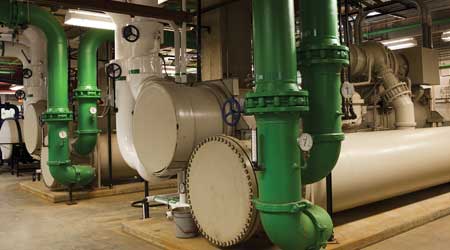Smart Building Technology Hold Promise, Peril in the Age of COVID-19
Smart devices and systems will have a huge role to play in determining how the new-normal workplace functions.
Will smart building technology help to shape building practices as employees return to the office? Experts point to a variety of ways that smart devices and systems could have a role in determining how the workplace functions.
Consider the Centers for Disease Control recommendation to stay at least six feet away from other people. Following that recommendation can be challenging enough in a grocery store. Organizations will have to figure out how employees can do that in an open office. Smart sensors could aid facility managers in tackling that challenge. “Occupancy data can help understand how space is used, which could potentially be a starting point for social distancing strategies as people move back into the office,” says Christina Halfpenny, executive director of the DesignLights Consortium.
Smart technology could also come into play in facilities that decide to bring in more outside air. Data could help get the benefits of more air changes while minimizing the energy penalty for doing so. For example, air flow could be increased more when spaces are occupied than when they are unoccupied, or less after they’ve been cleaned than before, says Joe Aamidor, managing director of Aamidor Consulting.
Occupancy data could also help answer a more general question about heating and cooling when social distancing policies are in place. “As people spread out,” asks Dan McJacobson, senior energy engineer with McGuire Engineers, “how does that affect HVAC?”
But there’s a flip side to the use of occupancy data: privacy. That issue raises numerous questions, McJacobson says: “If devices are picking up details about what’s happening in tenant space, are there implications for leasing agreements? Is it invasive to track how much time a person is spending in a wellness room? Would that information be provided to human resources?”
Or suppose an employee tested positive for COVID-19. Would occupancy data be used to track the person’s past movements to see who was exposed?
Privacy issues are especially relevant in owner-occupied spaces, where the information gathered could be more easily shared. What’s visible to whom? If the data is being stored somewhere, could it be obtained by law enforcement? Could it be sold?
“We’re opening a new door,” McJacobson says.
Despite the concerns about occupancy data, smart technology might in some ways help build confidence among employees who are nervous about being back in the office. If new HVAC practices emerge, smart systems could create visualizations showing, for example, air exchange rates, and push that content out to employees. “Those positive measures that you’re taking make people feel comfortable,” says Mo Fahim, practice leader, intelligent building technologies, Environmental Systems Design.
Email comments and questions to edward.sullivan@tradepress.com.
Related Topics:














